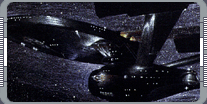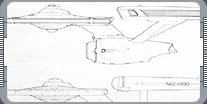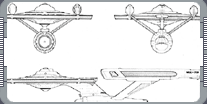
Redesigning the USS Enterprise NCC-1701 - By Matt Jefferies,
Richard Taylor, and Andrew Probert
Star Trek: The Motion Picture featured a beautiful new version of the
USS Enterprise NCC-1701 that had been reworked by several
talented artists.
 The design of the USS Enterprise NCC-1701 began to evolve long before work started on Star Trek: The Motion
Picture. Gene Roddenberry started thinking about updating it when he was working on the planned 'Star Trek:
Phase II' TV series. Fittingly, the first person who worked on the updated design was the Enterprise's
original creator - Matt Jefferies. He remembers that when work began on the TV series Roddenberry asked him
to come aboard as an associate producer. At the time Jefferies was working for Michael Landon as art
director on 'Little House on the Prairie.' This was a job that he adored, and had no intention of giving it
up, but he agreed to do some work as a consultant, on the strict understanding that it didn't interfere with
his regular job.
The design of the USS Enterprise NCC-1701 began to evolve long before work started on Star Trek: The Motion
Picture. Gene Roddenberry started thinking about updating it when he was working on the planned 'Star Trek:
Phase II' TV series. Fittingly, the first person who worked on the updated design was the Enterprise's
original creator - Matt Jefferies. He remembers that when work began on the TV series Roddenberry asked him
to come aboard as an associate producer. At the time Jefferies was working for Michael Landon as art
director on 'Little House on the Prairie.' This was a job that he adored, and had no intention of giving it
up, but he agreed to do some work as a consultant, on the strict understanding that it didn't interfere with
his regular job.
Jefferies says he wasn't keen to make drastic changes to the Enterprise, "As far as I was concerned, about
the only thing we could update was the engines, so I changed the design of the pods and the struts. I still
wanted an absolutely plain exterior. Anything that man makes is going to break down; why put him outside in
the worst possible environment when you can put him on the inside?" Jefferies goes on to say that he had
actually prepared drawings that showed the Enterprise with flat nacelles when he'd originally created the
ship. He had planned to present them if Roddenberry didn't like the first version of the Enterprise he saw
but since they hadn't been needed he'd file them away for future use. These drawings provided the basis for
his redesign. "I did the new working drawings with my board on the bed of the Hilton hotel in Tucson," he
 recalls, "because we were on location with 'Little House.' I came back and had them printed. [Model maker]
Don Loos had the engine pods finished, and was working on the struts, but around that time I had to quit.
They'd call up and say, 'We're having a meeting; come down right away.' I had to say, 'Hold it - it's
interfering too much.' Mike Landon was beginning to look out of the corner of his eye at me."
recalls, "because we were on location with 'Little House.' I came back and had them printed. [Model maker]
Don Loos had the engine pods finished, and was working on the struts, but around that time I had to quit.
They'd call up and say, 'We're having a meeting; come down right away.' I had to say, 'Hold it - it's
interfering too much.' Mike Landon was beginning to look out of the corner of his eye at me."
When the planned TV series evolved into a movie, Paramount hired Robert Abel & Associates to design and
produce the effects. The producers had hoped they would be able to use the models they'd already built for
the TV series, but Abel's art director Richard Taylor told them this would be impossible. As he explains,
there were two major problems; first, the model simply wasn't big enough. "I sat down with Roddenberry and
[Jeffery] Katzenberg and said, 'We are going to have to redesign the Enterprise because it needs to be
armatured from six sides, and it needs to have lighting systems in it. Also, if the camera is going to get
close to the model - say, up close to the windows - the model has to be big enough for us to give it detail.
Trying to film a model that is too small is deadly. The focus, lighting, depth of field, surface textures,
and much more come into play.' The Enterprise ended up being almost eight feet long. The model that was
under construction was maybe four feet long."
Taylor was also concerned that the lack of detail on the Enterprise would not do it justice on the big screen.
He would have liked to completely redesign the ship, at least in part, because he felt the shape was not
practical. But Roddenberry insisted that he keep the basic shape, so he focused his attention on reworking
the details. "My approach was to give it a stylization that was almost art deco," he explains. "Things
 became more elongated and more eleant than the TV series version. I tried to give it a very art deco feel;
for example, I added the parallel lines along the edge of the saucer. I spent weeks drawing and redrawing
the nacelles. The front end of them is almost a 1940 Ford grille." Although Taylor did much of the work
himself, he also involved illustrator Andrew Probert, who worked on areas such as the photon torpedo launcher
and the impulse engines. Probert is an avowed Trekkie, and remembered that in 'The Apple' Kirk had told
Scotty that, if necessary, he should separate the saucer section. So - at Probert's suggestion - the model
of the new Enterprise was designed to separate, although this was never seen on screen. Probert says he even
went to the trouble of giving the Enterprise landing gear. "Popular opinion indicated that [on the original
ship] the two triangular points on the underside of the saucer were actually two landing legs, and the third
one would be a telescoping leg in the doral-support cavity, so the saucer would have tricycle landing gear
for a planet landing. For The Motion Picture's Enterprise, I designed four landing pads on the underside of
the saucer."
became more elongated and more eleant than the TV series version. I tried to give it a very art deco feel;
for example, I added the parallel lines along the edge of the saucer. I spent weeks drawing and redrawing
the nacelles. The front end of them is almost a 1940 Ford grille." Although Taylor did much of the work
himself, he also involved illustrator Andrew Probert, who worked on areas such as the photon torpedo launcher
and the impulse engines. Probert is an avowed Trekkie, and remembered that in 'The Apple' Kirk had told
Scotty that, if necessary, he should separate the saucer section. So - at Probert's suggestion - the model
of the new Enterprise was designed to separate, although this was never seen on screen. Probert says he even
went to the trouble of giving the Enterprise landing gear. "Popular opinion indicated that [on the original
ship] the two triangular points on the underside of the saucer were actually two landing legs, and the third
one would be a telescoping leg in the doral-support cavity, so the saucer would have tricycle landing gear
for a planet landing. For The Motion Picture's Enterprise, I designed four landing pads on the underside of
the saucer."
Although Taylor and Probert kept the exterior of the ship very smooth, they were careful to give it an
interesting texture - the painted finish involved a complex process that made it change color in different
lights - and added many windows to the classic design. Taylor says they even gave the ship a few inhabitants.
"We used small transparent images of the sets inside the windows so that when the camera got close to the
 model it appeared that you could see something in the windows. By the way, in some of those windows you can
see photos of Mickey Mouse, Andy Probert, and others as a kind of in-joke."
model it appeared that you could see something in the windows. By the way, in some of those windows you can
see photos of Mickey Mouse, Andy Probert, and others as a kind of in-joke."
Taylor planned one final major departure for the Enterprise, but this was abandoned before the film was
released. His idea was that the warp engines would generate a very obvious energy field, so he designed the
nacelles to have light panels built into them. "I wanted to have an effect that radiates from the glowing
panels on the nacelles; something you could see. We would have had that streak when the ship was in motion."
The model of the new Enterprise was built at Magicam, and after Robert Abel & Associates left the film it
was filmed by Doug Trumbull's VFX team. It was then used in the next five movies before being brought out
retirement so Foundation Imaging could study it and build their own CG version.
|
|
"REDESIGNING THE USS ENTERPRISE NCC-1701" - DECEMBER 2001 ISSUE 32 STAR TREK: THE MAGAZINE COPYRIGHT OF
PARAMOUNT PICTURES.
|